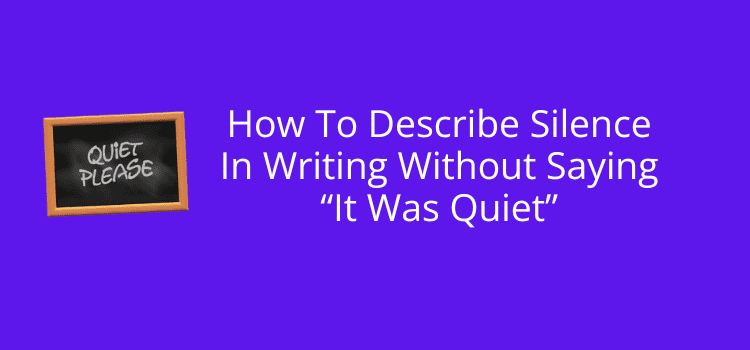
When you need to describe silence in writing, it can be a little bit challenging. How do you explain something you can’t see or touch?
Added to this is that silence not only means quiet. It can also mean peace, unease, awe, or even fear or dread.
Finding better ways to say it was quiet, which says little, is not always easy.
It takes imagination to describe a kind of silence that will have an effect on your readers.
What is silence in writing?
Silence in writing isn’t just the absence of sounds or noise. It can indicate the presence of stillness, emotion, anticipation, or even fear, which you often see in horror movies.
It’s the moment when no one speaks, but something is being said. It’s not dissimilar to describing pain because you can’t see it.
If you are writing fiction, silence can create tension between characters or mark a turning point in a scene.
It’s often better than dialogue because a reader needs to decide what is happening.
A pause in conversation might suggest discomfort, while a quiet setting may imply peacefulness or even foreboding.
When you describe a silence, it can help you slow the pacing, emphasize a mood, or create contrast.
Silence can highlight what’s missing, what’s unsaid, or what a character is trying to avoid.
It’s a valuable tool to use in your storytelling.
Rather than telling your reader that it’s quiet, show them what that quiet means.
If you need a little inspiration, read the lyrics for Simon and Garfunkel’s Sounds of Silence. It’s full of great lines to get you thinking.
How to use silence to say something
Silence or quiet is not nothing. It’s something, so you can use it.
Instead of simply telling the reader that a scene is quiet, show them what it means.
You can use sensory contrast to highlight the shift from sound to stillness.
“The nervous chatter faded. Now, even the wind seemed unsure if it should speak.”
You can show how characters react to the silence.
“She froze, afraid of the sound her shoes would make on the hardwood floor.”
Let the setting reflect the possible tension in the scene.
“Snow covered the village. Trees stood motionless, but they were listening.”
Using silence to express what your characters can’t say aloud.
“Neither spoke. But their eyes were finding the words they couldn’t bring themselves to utter.”
You can also try metaphors or similes.
“The silence settled like warm ash—soft, but impossible to ignore.”
Silence can comfort, isolate, or intimidate, but it always depends on your purpose.
When you use it effectively, it can sometimes describe the atmosphere more powerfully than dialogue. Never think of silence as an absence. It’s a deliberate, meaningful pause that you can fill.
Words to avoid when you describe silence
Some words can fall flat, especially if you use them too often.
Words like quiet, silent, still, and noiseless say something is missing, but not how it feels or what it does.
They’re vague, often overused, and don’t have much impact.
A phrase like “It was so quiet you could hear a pin drop” is a cliché that adds little to a scene.
Even peaceful or calm can be bland.
Instead of using these common and general terms, look for what the silence is doing to the space or the people within it.
Your best option is to swap weak words and phrases for more vivid and descriptive details.
Examples of quick fixes
Here are a few quick examples of replacing some common weak expressions with something more descriptive.
I’m sure you can do better, but these are only to give you a few clues to get started.
It was quiet.
The air felt heavy, like the world had forgotten to breathe.
The room was silent.
Only a ticking clock fought against the eerie silence.
They sat in stillness.
They didn’t move, didn’t speak, but their silence grew angry and vengeful.
She was frightened by the silence.
The distant sound of leaves, crackling underfoot, warned her she wasn’t alone.
You could hear a pin drop.
Even the walls seemed to hold their breath.
It was peaceful.
The tranquility wrapped around him like a worn blanket: familiar and comforting.
Literary quotes
Here are a handful of quotes from literature to give you more ideas about how to use silence in your writing.
“Her silence was a challenge, an affront. It was a locked door, and he was desperate to open it.”
The Silent Patient by Alex Michaelides
“The silence. The silence. The silence.”
The Road by Cormac McCarthy
“The White Silence seemed to sneer.”
The White Silence by Jack London
“The silences between them stretched and thickened like a viscous liquid.”
Little Fires Everywhere by Celeste Ng
“Some silences were heavy with things that had been said; others with things that had never been.”
The Vanishing Half by Brit Bennett
“They looked at each other and smiled, and in the silence that followed he felt a rush of love for her that was so strong it almost frightened him.”
Normal People by Sally Rooney
Summary
There’s no set formula for describing silence in writing because it’s always a challenge to describe things you can’t see.
All you can do is change your approach from simply saying it was quiet or silent to describing how it affects your characters or sets a scene.
You can describe a shift to or from silence by using metaphors, similes, or sensory contrasts.
The most crucial point is that you give it some thought and try to avoid clichés and well-worn expressions.
The examples in this article are basic, but hopefully they will give you a start in formulating your own words to describe silence in your writing.
If nothing else, they might give you some food for thought the next time you need to describe quiet or silence.
Related Reading: How To Describe A Night In Writing
Share This Article


